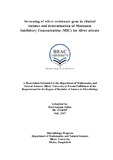| dc.contributor.advisor | Mannoor, Dr. Md. Kaiissar | |
| dc.contributor.advisor | Hossain, Dr. Mahboob | |
| dc.contributor.author | Safain, Kazi Sarjana | |
| dc.date.accessioned | 2018-01-17T06:08:50Z | |
| dc.date.available | 2018-01-17T06:08:50Z | |
| dc.date.copyright | 2017 | |
| dc.date.issued | 2017-07 | |
| dc.identifier.other | ID 13126017 | |
| dc.identifier.uri | http://hdl.handle.net/10361/9093 | |
| dc.description | This thesis report is submitted in partial fulfillment of the requirement for the degree of B.Sc in Microbiology, 2017. | en_US |
| dc.description | Cataloged from PDF version of thesis report. | |
| dc.description | Includes bibliographical references (pages 67-73). | |
| dc.description.abstract | Bacterial resistance to antibiotics has increased rapidly within recent years and has become a serious threat to public health. Ionic silver exhibits antimicrobial activity against a broad range of micro-organisms. As a consequence, the use of silver is increasing rapidly in the field of wound care and a wide variety of silver-containing dressings are now common place. However, concerns are being raised associated with the overuse of silver and the consequent emergence of silver resistant bacterial strains. Hence, the aim of this study was to investigate silver resistance in Klebsiella pneumoniae isolates both phenotypically and genotypically, isolated from nasal swab specimens which were collected from hospitalized acute respiratory infection patients. Confirmation of bacterial isolates was done by a range of methods including Gram staining, biochemical tests and Analytical profile index (API). Minimum Inhibitory Concentration (MIC) was determined to detect silver resistance and finally, molecular techniques such as Polymerase chain reaction (PCR) and sequencing were used for genotypic confirmation. MIC data showed that out of eleven isolates, growth of two isolates were inhibited at silver nitrate concentrations of 10 mg/L. SilE, among nine silver resistance gene types (silP, silE, silA, silB, silC, silR, silS, ORF105 and silABC), was identified by conventional PCR using gene specific primers. PCR result showed that one of the two isolates was positive for silE. The primer amplified product size was about 400 bp. Nucleotide sequencing and subsequent BLASTn analysis revealed 99% similarity with homologous bacterial strains harboring the resistance gene which includes E. coli, Salmonella enterica and Klebsiella oxytoca strains. From this study, it has been found for the very first time in Bangladesh that the clinically prevalent species Klebsiella pneumoniae harbored silver resistance gene, which provides a possible evidence for their unequal involvement in nosocomial and especially burn wound infections. Furthermore, it would be appropriate for future studies to assess the likelihood of widespread resistance to silver and the potential for silver to induce cross resistance to antibiotics, in light of its increasing usage within the healthcare setting in perspective of Bangladesh | en_US |
| dc.description.statementofresponsibility | Kazi Sarjana Safain | |
| dc.format.extent | 90 pages | |
| dc.language.iso | en | en_US |
| dc.publisher | BRAC University | en_US |
| dc.rights | BRAC University thesis are protected by copyright. They may be viewed from this source for any purpose, but reproduction or distribution in any format is prohibited without written permission. | |
| dc.subject | Silver resistance gene | en_US |
| dc.subject | Clinical isolates | en_US |
| dc.subject | Minimum Inhibitory Concentration | en_US |
| dc.subject | Bacterial resistance | en_US |
| dc.subject | Silver nitrate | en_US |
| dc.title | Screening of silver resistance gene in clinical isolates and determination of Minimum Inhibitory Concentration (MIC) for silver nitrate | en_US |
| dc.type | Thesis | en_US |
| dc.contributor.department | Department of Mathematics and Natural Sciences, BRAC University | |
| dc.description.degree | B. Mircobiology | |

